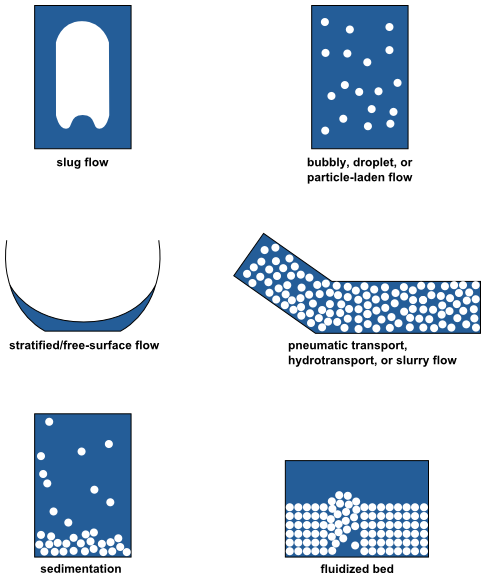Multiphase flow regimes can be grouped into four categories: gas-liquid or liquid-liquid flows; gas-solid flows; liquid-solid flows; and three-phase flows.
The following regimes are gas-liquid or liquid-liquid flows:
Bubbly flow: This is the flow of discrete gaseous or fluid bubbles in a continuous fluid.
Droplet flow: This is the flow of discrete fluid droplets in a continuous gas.
Slug flow: This is the flow of large bubbles in a continuous fluid.
Stratified/free-surface flow: This is the flow of immiscible fluids separated by a clearly-defined interface.
See Figure 14.1: Multiphase Flow Regimes for illustrations of these regimes.
The following regimes are gas-solid flows:
Particle-laden flow: This is flow of discrete particles in a continuous gas.
Pneumatic transport: This is a flow pattern that depends on factors such as solid loading, Reynolds numbers, and particle properties. Typical patterns are dune flow, slug flow, and homogeneous flow.
Fluidized bed: This consists of a vessel containing particles, into which a gas is introduced through a distributor. The gas rising through the bed suspends the particles. Depending on the gas flow rate, bubbles appear and rise through the bed, intensifying the mixing within the bed.
See Figure 14.1: Multiphase Flow Regimes for illustrations of these regimes.
The following regimes are liquid-solid flows:
Slurry flow: This flow is the transport of particles in liquids. The fundamental behavior of liquid-solid flows varies with the properties of the solid particles relative to those of the liquid. In slurry flows, the Stokes number (see Equation 14–4) is normally less than 1. When the Stokes number is larger than 1, the characteristic of the flow is liquid-solid fluidization.
Hydrotransport: This describes densely-distributed solid particles in a continuous liquid.
Sedimentation: This describes a tall column initially containing a uniform dispersed mixture of particles. At the bottom, the particles will slow down and form a sludge layer. At the top, a clear interface will appear, and in the middle a constant settling zone will exist.
See Figure 14.1: Multiphase Flow Regimes for illustrations of these regimes.



